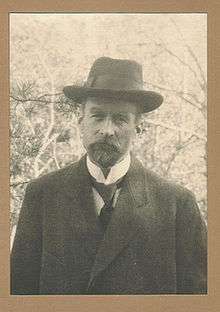Helge von Koch
| Helge von Koch | |
|---|---|
 Niels Fabian Helge von Koch | |
| Born |
25 January 1870 Stockholm, Sweden |
| Died |
11 March 1924 (aged 54) Danderyd Municipality, Sweden |
| Residence | Sweden |
| Nationality | Swedish |
| Fields | Mathematician |
| Institutions | Royal Institute of Technology, Stockholm University College |
| Alma mater | Stockholm University College, Uppsala University |
| Known for | Koch snowflake |
Niels Fabian Helge von Koch (25 January 1870 – 11 March 1924) was a Swedish mathematician who gave his name to the famous fractal known as the Koch snowflake, one of the earliest fractal curves to be described.
He was born into a family of Swedish nobility. His grandfather, Nils Samuel von Koch (1801–1881), was the Attorney-General of Sweden. His father, Richert Vogt von Koch (1838–1913) was a Lieutenant-Colonel in the Royal Horse Guards of Sweden. He was enrolled at the newly created Stockholm University College in 1887 (studying under Gösta Mittag-Leffler), and at Uppsala University in 1888, where he also received his bachelor's degree (filosofie kandidat) since non-governmental college in Stockholm had not yet received the rights to issue degrees. He received his Ph.D. in Uppsala in 1892. He was appointed professor of mathematics at the Royal Institute of Technology in Stockholm in 1905, succeeding Ivar Bendixson, and became professor of pure mathematics at Stockholm University College in 1911.
Von Koch wrote several papers on number theory. One of his results was a 1901 theorem proving that the Riemann hypothesis is equivalent to a stronger form of the prime number theorem.
He described the Koch curve in a 1904 paper entitled "On a continuous curve without tangents constructible from elementary geometry" (original French title: "Sur une courbe continue sans tangente, obtenue par une construction géométrique élémentaire").[1]
He was an Invited Speaker of the ICM in 1900 in Paris with talk Sur la distribution des nombres premiers[2] and in 1912 in Cambridge, England with talk On regular and irregular solutions of some infinite systems of linear equations.[3]
Notes
- ↑ Von Koch, Helge (1904). "Sur une courbe continue sans tangente, obtenue par une construction géométrique élémentaire". Arkiv för Matematik. 1: 681–704.
- ↑ Sur la distribution des nombres premiers, Proceedings of the ICM, 1900 v. 1
- ↑ On regular and irregular solutions of some infinite systems of linear equations, Proceedings of the ICM, 1912 v. 1
References
- Marquis of Ruvigny and Raineval (1911). The Plantagenet Roll of the Blood Royal: Mortimer-Percy Volume). pp. 250–251.
- Gerald Edgar, ed. (1993). Classics on Fractals. Addison-Wesley.
contains an English translation of the paper 'On a continuous curve...'
External links
- Works by or about Helge von Koch at Internet Archive
- O'Connor, John J.; Robertson, Edmund F., "Helge von Koch", MacTutor History of Mathematics archive, University of St Andrews.
- Helge von Koch at the Mathematics Genealogy Project